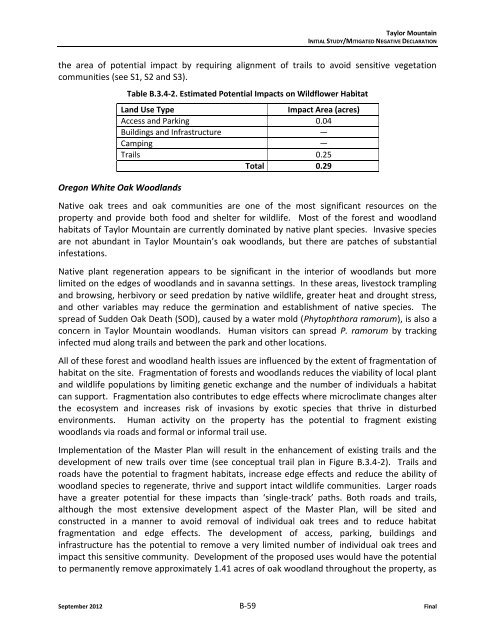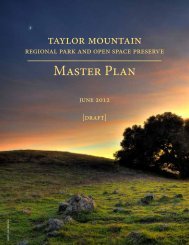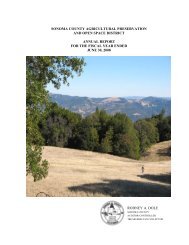Initial Study MND - Sonoma County Agricultural Preservation and ...
Initial Study MND - Sonoma County Agricultural Preservation and ...
Initial Study MND - Sonoma County Agricultural Preservation and ...
You also want an ePaper? Increase the reach of your titles
YUMPU automatically turns print PDFs into web optimized ePapers that Google loves.
Taylor MountainINITIAL STUDY/MITIGATED NEGATIVE DECLARATIONthe area of potential impact by requiring alignment of trails to avoid sensitive vegetationcommunities (see S1, S2 <strong>and</strong> S3).Table B.3.4-2. Estimated Potential Impacts on Wildflower HabitatL<strong>and</strong> Use TypeImpact Area (acres)Access <strong>and</strong> Parking 0.04Buildings <strong>and</strong> Infrastructure —Camping —Trails 0.25Total 0.29Oregon White Oak Woodl<strong>and</strong>sNative oak trees <strong>and</strong> oak communities are one of the most significant resources on theproperty <strong>and</strong> provide both food <strong>and</strong> shelter for wildlife. Most of the forest <strong>and</strong> woodl<strong>and</strong>habitats of Taylor Mountain are currently dominated by native plant species. Invasive speciesare not abundant in Taylor Mountain’s oak woodl<strong>and</strong>s, but there are patches of substantialinfestations.Native plant regeneration appears to be significant in the interior of woodl<strong>and</strong>s but morelimited on the edges of woodl<strong>and</strong>s <strong>and</strong> in savanna settings. In these areas, livestock trampling<strong>and</strong> browsing, herbivory or seed predation by native wildlife, greater heat <strong>and</strong> drought stress,<strong>and</strong> other variables may reduce the germination <strong>and</strong> establishment of native species. Thespread of Sudden Oak Death (SOD), caused by a water mold (Phytophthora ramorum), is also aconcern in Taylor Mountain woodl<strong>and</strong>s. Human visitors can spread P. ramorum by trackinginfected mud along trails <strong>and</strong> between the park <strong>and</strong> other locations.All of these forest <strong>and</strong> woodl<strong>and</strong> health issues are influenced by the extent of fragmentation ofhabitat on the site. Fragmentation of forests <strong>and</strong> woodl<strong>and</strong>s reduces the viability of local plant<strong>and</strong> wildlife populations by limiting genetic exchange <strong>and</strong> the number of individuals a habitatcan support. Fragmentation also contributes to edge effects where microclimate changes alterthe ecosystem <strong>and</strong> increases risk of invasions by exotic species that thrive in disturbedenvironments. Human activity on the property has the potential to fragment existingwoodl<strong>and</strong>s via roads <strong>and</strong> formal or informal trail use.Implementation of the Master Plan will result in the enhancement of existing trails <strong>and</strong> thedevelopment of new trails over time (see conceptual trail plan in Figure B.3.4-2). Trails <strong>and</strong>roads have the potential to fragment habitats, increase edge effects <strong>and</strong> reduce the ability ofwoodl<strong>and</strong> species to regenerate, thrive <strong>and</strong> support intact wildlife communities. Larger roadshave a greater potential for these impacts than ‘single-track’ paths. Both roads <strong>and</strong> trails,although the most extensive development aspect of the Master Plan, will be sited <strong>and</strong>constructed in a manner to avoid removal of individual oak trees <strong>and</strong> to reduce habitatfragmentation <strong>and</strong> edge effects. The development of access, parking, buildings <strong>and</strong>infrastructure has the potential to remove a very limited number of individual oak trees <strong>and</strong>impact this sensitive community. Development of the proposed uses would have the potentialto permanently remove approximately 1.41 acres of oak woodl<strong>and</strong> throughout the property, asSeptember 2012 B-59 Final







